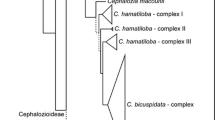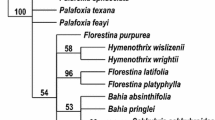Abstract
Phylogenies of Old WorldTrifolium species were constructed using nucleotide sequence data of the internal transcribed spacers (ITS) of nuclear ribosomal DNA and chloroplast DNA restriction site data from PCR-amplified genes and genic regions (rbcL,trnK, andrpoC1–C2). Biogeography, morphological evolution, and the existing classification forTrifolium were examined. The genusTrifolium is strongly supported as monophyletic, however, only one small section (Chronosemium) is monophyletic, although the data are in conflict regarding its placement. The two largest sections of the genus, Sects.Lotoidea andTrifolium, are not supported as monophyletic, as currently circumscribed. Many members of Sect.Lotoidea are basal within the genus, supporting previously-proposed hypotheses concerning plesiomorphic morphological characters and a Mediterranean-Mideast biogeographic origin of the genus.
Similar content being viewed by others
References
Badr A. (1995) Electrophoretic studies of seed proteins in relation to chromosomal criteria and the relationships of some taxa ofTrifolium. Taxon 44: 183–191.
Baldwin B. G., Sanderson M. J., Porter J. M., Wojciechowski M. F., Campbell C. S., Donoghue M. J. (1995) The ITS region of nuclear ribosomal DNA: a valuable source of evidence of angiosperm phylogeny. Ann. Missouri Bot. Gard. 82: 247–277.
Bobrov E. G. (1967) On the span of the genusTrifolium s.l. Bot. Zurn., S.S.R. 52: 1593–1599 (Russian with English summary).
Boissier E. (1872)Trifolium. In: Flora Orientalis, 2. Geneva and Basel, pp. 110–156.
Britten E. J. (1963) Chromosome numbers in the genusTrifolium. Cytologia 28: 428–449.
Bullitta S., Hayward M. D. (1996) Application of RAPD markers to a study of species relationships in the genusTrifolium. In: Pickersgill B., Lock J. M. (eds.) Advances in Legume Systematics, Part 8: Legumes of Economic Importance. Royal Botanic Gardens, Kew, pp. 127–135.
Celakovsky L. (1874) Über den Aufbau der GattungTrifolium Österr. Bot Z. 24: 37–45, 75–82.
Dowling T. E., Moritz C., Palmer J. D. (1990) Nucleic acids II: Restriction site analysis. In: Hillis D. M., Moritz C., (eds.) Molecular Systematics. Sinauer Associates, Sunderland, pp. 250–317.
Downie S. R., Katz-Downie D. S., Rogers E. J., Zujewski H. L., Small E. (1998) Multiple independent losses of the plastidrpoC1 intron inMedicago (Fabaceae) as inferred from phylogenetic analyses of nuclear ribosomal DNA internal transcribed spacer sequences. Canad. J. Bot. 76: 791–803.
Doyle J. J. (1995) DNA data and legume phylogeny: a progress report. In: Crisp M., Doyle J. J. (eds.) Advances in Legume Systematics, Part 7: Phylogeny. Royal Botanic Gardens, Kew, pp. 11–30.
Doyle J. J., Doyle J. L. (1987) A rapid DNA isolation procedure for small quantities of fresh leaf tissue. Phytochem. Bull. 19: 11–15.
El-Kholy M. A. (1990) Cytology of someTrifolium species. Ph.D. Thesis, unpubl. Al-Azhar University, Cairo.
Farris J. S., Källersjo M., Kluge A. G., Bult C. (1995) Testing significance of congruence. Cladistics 10: 315–320.
Felsenstein J. (1985) Confidence limits on phylogenies: an approach using the bootstrap. Evolution 39: 783–791.
Gillett J. M. (1952) The genusTrifolium in southern Arabia and in Africa south of the Sahara. Kew Bulletin, Royal Botanic Gardens, Kew 7: 367–404.
Gillett J. M. (1985) Taxonomy and morphology. Clover Science and Technology, Agronomy Monograph 25: 7–69.
Hendrych R. (1978) Ein Versuch, die Arealentwicklung der GattungChrysapsis zu erläutern. Preslia 50: 119–137.
Heyn C. C. (1981) Trifolieae. In: Polhill R. M., Raven P. H. (eds.) Advances in Legume Systematics, Part 1: Royal Botanic Gardens, Kew, pp. 383–385.
Higgins D. G., Bleasby A. J., Fuchs R. (1992) Clustal V: Improved software for multiple sequence alignment. Comp. Appl. Biosciences 8: 189–191.
Hossain M. (1961) A revision ofTrifolium in the Nearer East. Notes from Royal Botanic Garden Edinburgh, Aberdeen University Press 23: 387–481.
Hu J.-M., Lavin M., Wojciechowski M., Sanderson M. (1999) Phylogenetic systematics of the tribe Millettieae (Leguminosae) based ontrnK/matK sequences and its implications for evolutionary patterns in Papilionoideae. Amer. J. Bot. 87: 418–430.
Johnson L. A., Soltis D. E. (1994)matK DNA sequences and phylogenetic reconstruction in Saxifragaceaes. str. Syst. Bot. 19: 143–156.
Koch C. (1835)Trifolium. In: Synopsis Florae Germanicae et Helvetica, Vol. 1. Wilmans, Francofurtis and Moenum, pp. 167–176.
Kozuharov S. I., Petrova A. V., Markova T. A. (1975) In: Lîve A. (ed.) IOPB chromosome number reports XLVII. Taxon 24: 145–146.
Lavin M., Doyle J. J., Palmer J. D. (1990) Evolutionary significance of the loss of the chloroplast-DNA inverted repeat in the Leguminosae. Evolution 44: 390–402.
Liston A. (1992) Variation in the chloroplast genesrpoC1 andrpoC2 of the genusAstragalus (Fabaceae): evidence from restriction site mapping of a PCR-amplified fragment. Amer. J. Bot. 79: 953–961.
Liston A., Wheeler J. A. (1994) The phylogenetic position of the genusAstragalus (Fabaceae): evidence from the chloroplast genesrpoC1 andrpoC2. Biochem. Syst. Ecol. 22: 377–388.
Milligan B. G. (1991) Chloroplast DNA diversity within and among populations ofTrifolium pratense. Curr. Genet. 19: 411–416.
Milligan B. G., Hampton J. N., Palmer J. D. (1989) Dispersed repeats and structural reorganization in subclover chloroplast DNA. Mol. Biol. Evol. 6: 355–368.
Norris D. O. (1956) Legumes and Rhizobium Symbiosis. Emp. J. Exp.
Olmstead R. G., Palmer J. D. (1994) Chloroplast DNA systematics: a review of methods and data analysis. Amer. J. Bot. 81: 1205–1224.
Polhill R. M. (1981) Papilionoideae. In: Polhill R. M., Raven P. H. (eds.) Advances in Legume Systematics, Part 1. Royal Botanic Gardens, Kew, pp. 191–208.
Pritchard A. J. (1962) Number and morphology of chromosomes in African species in the genusTrifolium L. Australian J. Agric. Res. 13: 1023–1029.
Raven P. H., Polhill R. M. (1981) Biogeography of the Leguminosae. In: Polhill R. M., Raven P.H. (eds.) Advances in Legume Systematics, Part 1. Royal Botanic Gardens, Kew, pp. 27–34.
Rieseberg L. H., Hanson M. A., Philbrick C. T. (1992) Androdioecy is derived from dioecy in Datiscaceae: evidence from restriction site mapping of PCR-amplified chloroplast DNA fragments. Syst. Bot. 17: 324–336.
Saghai-Maroof M. A., Soliman K. M., Jorgensen R. A., Allard R. W. (1984) Ribosomal DNA spacer length polymorphism in barley: Mendelian inheritance, chromosomal location and population dynamics. Proc. Natl. Acad. Sci. USA 81: 8014–8018.
Sanderson M. J., Liston A. (1995) Molecular phylogenetic systematics of Galegeae, with special reference toAstragalus. In: Crisp M., Doyle J. J. (eds.) Advances in Legume Systematics, Part 7: Phylogeny. Royal Botanic Gardens, Kew, pp. 331–350.
Sanderson M. J., Liston A., Wojciechowski M. F. (1996) Diversification rates in a temperate legume clade: are there “so many species” ofAstragalus (Fabaceae)? Amer. J. Bot. 83: 1488–1502.
Sanger F., Nicklen S., Coulson A. R. (1977) DNA sequencing with chain-terminating inhibitors. Proc. Natl. Acad. Sci., USA 74: 5463–5467.
Senn H. A. (1938) Chromosome number relation-ships in the Leguminosae. Biblio. Genetica 12: 175–336.
Small E. (1989) The evolution of genera in the Leguminosae. In: Stirton C. H., Zarucchi J. L. (eds.) Advances in Legume Biology. Monographs in Systematic Botany, from the Missouri Botanical Garden 29: 467–486.
Steele K. P., Udpa B., Chinn D., Curameng O., Throckmorton D., Wojciechowski M. F. (1999) [abstract] Phylogenetic relationships of Tribes Trifolieae and Viceae (Fabaceae). XVI International Botanical Congress, St. Louis, Missouri, USA p. 390.
Steele K. P., Udpa B., Chinn D., Curameng O., Throckmorton D., Wojciechowski M. F., Watson L. E., Liston A., Sayed-Ahmed H., Downie S. R., Wojciechowski M. F. (1998) [abstract] Molecular systematics of the Trifolieae: phylogenetic analyses of nuclear and chloroplast DNA sequences. XVTrifolium Conference, Madison, Wisconsin, USA.
Steiner J. J., Robinson W. A, Liston A., Taylor N. L. (1997) ITS and RAPD phylogenetic hypotheses and the ecological distributions of North AmericanTrifolium L. (Fabaceae). Amer. J. Bot. 84 [Suppl.]: 235–236.
Swofford D. L. (1993) PAUP: Phylogenetic Analysis Using Parsimony, Version 3.1.1. Smithsonian Institution, Washington, DC.
Swofford D. L. (1999) PAUP*. Phylogenetic Analysis Using Parsimony (* and Other Methods), Version 4. Sinauer Associates, Sunderland.
Taylor N. L. (1985) Clovers around the world. Clover Science and Technology, Agronomy Monograph 25: 1–6.
Wexelsen H. (1928) Chromosome numbers and morphology inTrifolium. University of California Publications in Agricultural Sciences 2: 355–376.
White T. J., Birns T., Lee S., Taylor J. (1990) Amplification and direct sequencing of fungal ribosomal RNA genes for phylogenetics. In: Innis M., Gelfand D., Sninsky J., White T. (eds.) PCR protocols: A guide to methods and applications. Academic Press, San Diego, pp. 315–322.
Winberg G., Hammarskjöld M.-L. (1980) Isolation of DNA from agarose gels using DEAE-paper. Application to restriction site mapping of adenovirus type 16 DNA. Nucleic Acids Res. 8: 253–264.
Wojciechowski M. F., Sanderson M. J., Baldwin B. G., Donoghue M. J. (1993) Monophyly of aneuploidAstragalus (Fabaceae): evidence from nuclear ribosomal DNA internal transcribed spacer sequences. Amer. J. Bot. 80: 711–722.
Wolfe A. D., Elisens W. J., Watson L. E., dePamphilis C. W. (1997) Using restriction site variation of PCR-amplified cpDNA genes for phylogenetic analysis of Tribe Cheloneae (Scrophulariaceae). Amer. J. Bot. 84: 555–564.
Wolfe K. H. (1991) Protein-coding genes in chloroplast DNA: Compilation of nucleotide sequences, database entries and rates of molecular evolution. In: Bogorad L., Vasil I. K. (eds.) The photosynthetic apparatus: molecular biology and operation, Vol. 7B, Cell culture and somatic cell genetics in plants. Academic Press, New York, pp. 467–482.
Yokota Y., Kawata T., Iida Y., Kato A., Tanifuji S. (1989) Nucleotide sequences of the 5.8S rRNA gene and internal transcribed spacer regions in carrot and broad bean ribosomal DNA. J. Mol. Evol. 29: 294–301.
Zohary M. (1972) Origins and evolution in the genusTrifolium. Bot. Notiser. 125: 501–511.
Zohary M., Heller D. (1984) The genusTrifolium. The Israel Academy of Science, Jerusalem.
Author information
Authors and Affiliations
Rights and permissions
About this article
Cite this article
Watson, L.E., Sayed-Ahmed, H. & Badr, A. Molecular phylogeny of Old WorldTrifolium (Fabaceae), based on plastid and nuclear markers. Pl Syst Evol 224, 153–171 (2000). https://doi.org/10.1007/BF00986340
Received:
Accepted:
Issue Date:
DOI: https://doi.org/10.1007/BF00986340




